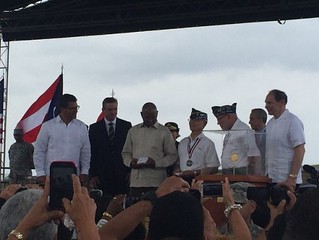
PREV ARTICLE
NEXT ARTICLE
FULL ISSUE
PREV FULL ISSUE
BORINQUENEERS CONGRESSIONAL GOLD MEDAL CEREMONY
Hillery York is a collections manager for the National Numismatic Collection. On July 6, 2016 she posted an article on the
Smithsonian's O Say Can You See? blog about the award ceremony held in Puerto Rico for the Borinqueneers Congressional Gold
Medal. -Editor
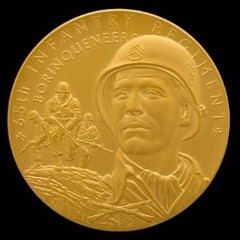 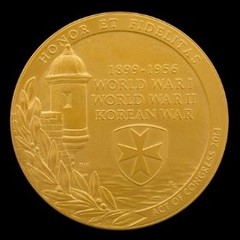
As the rain clouds began to blow out to sea over the fortress of Castillo San Felipe del Morro, I looked out over the crowd of veterans and their families, knowing that not even rain could ruin this day for them. On April 27, 2016, a team of Smithsonian staff traveled to Puerto Rico with the most recently issued Congressional Gold Medal, which was presented to the U.S. Army 65th Infantry Regiment, nicknamed "The Borinqueneers." According to the Senate's website, the medal was given in recognition of the regiment's "pioneering military service, devotion to duty, and many acts of valor in the face of adversity." The Congressional Gold Medal is the "highest expression of national appreciation for distinguished achievements and contributions by individuals or institutions," according to the site. The first Congressional Medals were issued by the Continental Congress and struck in Paris during the American Revolution to "serve as an expression of national appreciation," according to the Congressional Research Service. Long before the power of the Internet, medals were small, portable objects on which images and messages could be struck and disseminated around the country and around the world. The medals were used to commemorate "distinguished contributions, dramatize the virtues of patriotism, and perpetuate the remembrance of great events." It should come as no surprise that the first recipient of the Congressional Gold Medal was General George Washington, the commander of the Continental Army. Washington received the medal for "wise and spirited conduct" in the Siege of Boston in June 1775.
To date, over 300 Congressional Gold Medals have been awarded. My congratulations to the Borinqueneers, whose patriotism inspires so many of us.
Launch ceremonies for coins and medals are a unique opportunity for numismatists. Thanks to Hillery and the NNC staff for documenting the
event. The article omitted the numismatic details however, so below is some information from the U.S. Mint site. -Editor
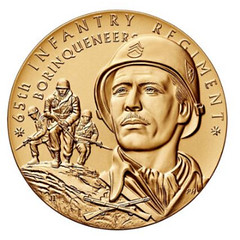 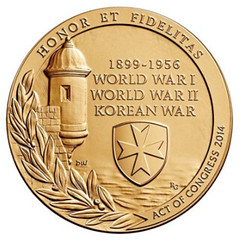
The obverse design depicts a portrait of a fictional Borinqueneer. The soldiers in the background are in an inverted “V” formation, taking the high ground with fixed bayonets during an assault on the enemy during the Korean War. The inscriptions are “65th INFANTRY REGIMENT” and “BORINQUENEERS.” The Crossed Rifles insignia appears at the bottom of the design. The reverse design depicts the Castillo de San Felipe del Morro of San Juan, Puerto Rico. It is a 16th-century citadel, a central symbol of Puerto Rico and the preferred military command ceremonial parade site of the 65th Infantry Regiment. The inscriptions are “HONOR ET FIDELITAS,” “1899–1956,” “WORLD WAR I,” “WORLD WAR II,” “KOREAN WAR,” and “ACT OF CONGRESS 2014.” Obverse Designer: Joel Iskowitz
To read the complete articles, see:

Wayne Homren, Editor The Numismatic Bibliomania Society is a non-profit organization promoting numismatic literature. See our web site at coinbooks.org. To submit items for publication in The E-Sylum, write to the Editor at this address: whomren@gmail.com To subscribe go to: https://my.binhost.com/lists/listinfo/esylum All Rights Reserved. NBS Home Page Contact the NBS webmaster 
|
